| |
 |
|
 |
|
 |
|
 |
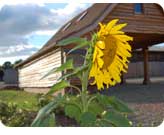 |
|
Eco-homes
Concern for the state of the environment is key to the design of Living Village houses. Wherever possible we use materials that are non-polluting and are renewable, local or reclaimed. All our houses are built to the highest environmental specification practicable for any given site. We believe that no mainstream developers offer housing which comes anywhere near these standards.
|
 |

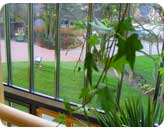 |
|
Mediterranean atmosphere
All our houses have large windows and many have sun spaces
and internal balconies. This contributes to the sense of wellbeing,
creativity and comfort experienced by residents. The sunlight
flooding into the houses and the warm, dry interiors give
the feel of a Mediterranean climate.
Free light and heat
We face the houses towards the sun and use high performance
windows to draw in as much light and warmth as possible. We
make the most of this free energy with high levels of insulation,
double glazing, draught-free building techniques and solar
panels.
The thermal onion
Living Villages houses are designed to maximise the effectiveness of
heating energy used. Heat is input to the dwelling in the areas where
it is most needed: living rooms, bathrooms etc. and left to permeate
upwards through the less frequently used areas. Bedrooms are unheated,
relying on this upwards movement of heat (the general principle has
been called ‘the thermal onion’, meaning that heat is released into
the centre of the onion and gradually moves outwards, thus heating
the outer layers to a lesser extent - the outer layers serving to
insulate the inner). It is intended that in periods of extremely cold
weather, the heating in the upper rooms can be supplemented by small electric heaters.
Insulated and draught-proof
The heat generated is retained by a highly insulated building
shell, draught-proof windows and doors and thermal mass within
the building. (Thermal mass is dense material, like brick,
stone or concrete that acts like a storage heater, taking
in heat during the day and letting it out gently as the house
cools down.)
Solar-powered living
Building our houses in a sunny position also means that we
can fit solar panels onto the roofs and use sunlight to heat
water and generate electricity – for free.
Recycled heat
Where fitted, heat recovery systems extract the warm, moist
air from bathrooms and kitchens and take the heat out of it.
The stale air is vented outside, then the collected heat is
transferred to fresh air coming into the building and distributed
to the bedrooms and living rooms at a constant, comfortable
temperature.
|
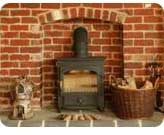 |
|
A real fire
For cold spells, our houses are fitted with gas condensing
boilers that can react quickly and efficiently to any changes
in room temperature as well as providing a heat boost to the
water temperature if necessary. And for those who like a real
fire in the winter, we’ve installed flues for wood-burning
stoves.
Anti-allergy benefits
As our eco-houses are filled with daylight and free from damp
and draughts, they provide an exceptionally healthy living
environment. The ventilation systems help to eliminate unhealthy
dampness and mould. Air intake filters on the mechanical heat
recovery systems prevent dust entering with the incoming fresh
air, and the internal vacuum cleaner systems extract dust
from the house and vent it to the outside – particularly
beneficial to asthma and hayfever sufferers.
Natural,
non-toxic materials
For the health of the residents and the planet, wherever possible
we build with materials that are free from toxins or harmful
products of the petro-chemical industry. Even our paint is
non-toxic.
Eco-friendly building
Producing and transporting building materials burns energy,
so we use locally-sourced materials wherever possible.
|
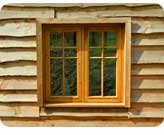
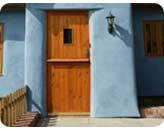 |
|
Timber
We use a lot of timber from sustainable sources in our house
construction.
Trees grow using energy from the sun, they don’t pollute,
they produce oxygen, absorb CO2 and provide a wildlife habitat.
Lime
Sometimes we have to be practical and use cement, but we try
to use lime instead where we can. We use lime render on our
houses. Lime has been used as a building material for thousands
of years, and although energy and CO2 are used in its production
it gently returns back to limestone in time, absorbing CO2
in the process.
Reclaimed building materials
We also use reclaimed materials, particularly bricks, slates
and roof tiles wherever we can. Not only are they eco-friendly,
they also help new buildings to blend in with their surroundings.
Flexible living
Living Villages houses are designed to be flexible, taking
into account the changing needs of families over the years.
Internal stud walls can be moved to alter the size
of rooms to suit your requirements.
Work
from home
The flexible room layouts are also ideally suited to those
who want to work from home, and the neighbourhoods are wired
for broadband and other technological advances. |
| |
|
|
| |
|
|
| |
 |
| |
|
|
|
|

